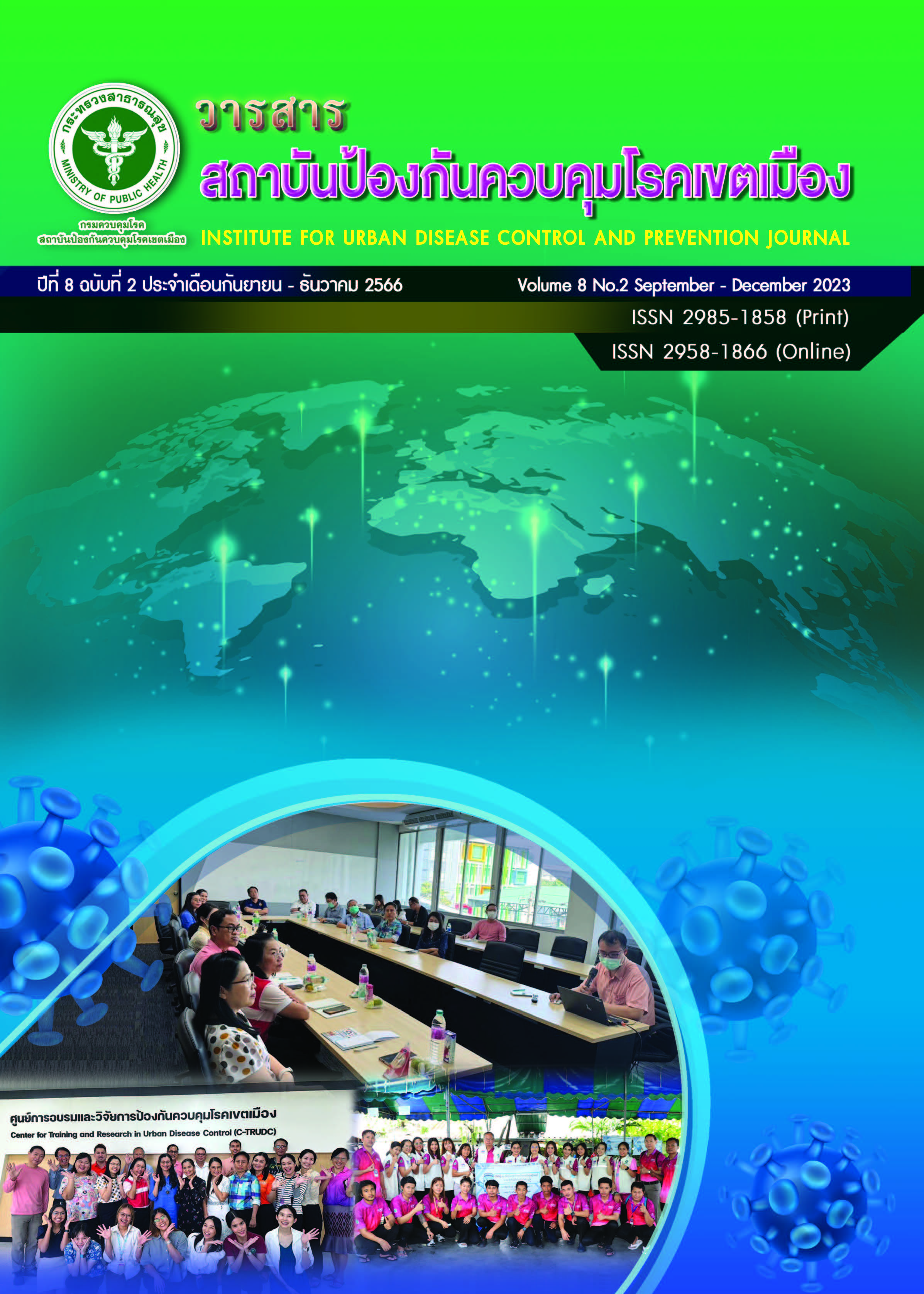ความชุกและปัจจัยที่มีความสัมพันธ์กับอาการเส้นประสาทมีเดียนบริเวณข้อมือของบุคลากรในสถาบันการศึกษาแห่งหนึ่ง
Main Article Content
บทคัดย่อ
การศึกษานี้เป็นการศึกษาแบบภาคตัดขวาง เพื่อศึกษาความชุกและปัจจัยที่มีความสัมพันธ์กับอาการกดทับเส้นประสาทบริเวณข้อมือของบุคลากรในสถาบันการศึกษาแห่งหนึ่ง การวิจัยครั้งนี้คัดเลือกกลุ่มตัวอย่าง โดยใช้วิธีการสุ่มตัวอย่างแบบเจาะจง ซึ่งจากการได้รับการตอบกลับแบบสอบถาม และคัดเลือกแบบสอบถามที่มีการตอบครบถ้วนสมบูรณ์ ได้จำนวน 252 คน จากผลการศึกษาพบว่า กลุ่มตัวอย่างมีความชุกของกลุ่มอาการกดทับเส้นประสาทบริเวณข้อมือมีอาการ จำนวน 209 คน คิดเป็นร้อยละ 82.9 และไม่มีอาการปวดจำนวน 43 คิดเป็นร้อยละ 17.1 โดยส่วนใหญ่มีความรุนแรงในลักษณะความถี่ที่ไม่เคยปวดเลย จำนวน 131 คน คิดเป็นร้อยละ 52.0 และมีอาการปวดเล็กน้อยจำนวน 121 คน คิดเป็นร้อยละ 48.0 และมีความสามารถในการใช้มือเป็นการปฏิบัติงานปกติ จำนวน 164 คน คิดเป็นร้อยละ 65.1 และปฎิบัติได้น้อย จำนวน 88 คน คิดเป็นร้อยละ 34.9 และเมื่อตรวจร่างกายด้วยวิธีเฉพาะทางของฟาเลนส์เทส (Phalen’s test) เพื่อยืนยันถึงอาการปวดจากการกดทับเส้นประเส้นบริเวณข้อมือ พบว่า มีอาการชาบริเวณนิ้วหัวแม่มือ นิ้วชี้ นิ้วกลาง มีอาการปวดจำนวน 33 คน คิดเป็นร้อยละ 13.1 ปัจจัยที่มีความสัมพันธ์กับอาการกดทับเส้นประสาทบริเวณข้อมือ พบว่า ปัจจัยที่มีความสัมพันธ์กับอาการกดทับเส้นประสาทบริเวณข้อมือ ได้แก่ เพศ ระดับการศึกษา ลักษณะงานที่ทำ งานคอมพิวเตอร์ และการดื่มเครื่องดื่มที่มีแอลกอฮอล์ อย่างมีนัยสำคัญทางสถิติ
Article Details

อนุญาตภายใต้เงื่อนไข Creative Commons Attribution-NonCommercial-NoDerivatives 4.0 International License.
บทความที่พิมพ์ในวารสารสถาบันป้องกันควบคุมโรคเขตเมือง ถือว่าเป็นผลงานวิชาการ งานวิจัยและวิเคราะห์ ตลอดจนเป็นความเห็นส่วนตัวของผู้เขียนเอง ไม่ใช่ความเห็นของสถาบันป้องกันควบคุมโรคเขตเมือง หรือคณะบรรณาธิการแต่ประการใด ผู้เขียนจำต้องรับผิดชอบต่อบทความของตน
เอกสารอ้างอิง
Shankar N. Work from home during COVID-19-disequilibrium of mental health and well-being among employees. EXCLI J. 2021;20:1287-89.
Rhode BA, Rhode WS. Occupational risk factors for shoulder tendon disorders 2015 update. MOJ Orthop Rheumatol. 2015;3(4):85-91.
Jairakdee Y, Thermworakul L, Sathianpantarit P. Carpal Tunnel Syndrome. Journal of Health Science. 2021;30(Supplement 3):S575-S582.
Sarsak HI. Working from home: Self-assessment computer workstation set-up. World Federation of Occupational Therapists Bulletin. 2022;78(1):59-66.
Pangsuwan S. A study of the prevalence and risk factors of carpal tunnel syndrome in employees at the Royal Irrigation Hospital. Srinakharinwirot University (Journal of Science and Technology). 2017;9(17):163-73.
Hagberg M, Morgenstern H, Kelsh M. Impact of occupations and job tasks on the prevalence of carpal tunnel syndrome. Scand J Work Environ Health. 1992;18(6):337-45.
ประภาพร กองทองดี, รัฐไท พรเจริญ, ชาคร ผาสุวรรณ. การออกแบบและพัฒนาผลิตภัณฑ์เพื่อบรรเทาอาการบาดเจ็บกล้ามเนื้อแขนและข้อมือ. วารสารวิชาการศิลปะสถาปัตยกรรมศาสตร์ มหาวทยาลัยนเรศวร. 2556;(4)2:68-79.
กระทรวงแรงงาน. ประกาศกระทรวงแรงงาน เรื่อง กำหนดชนิดของโรคซึ่งเกิดขึ้นตามลักษณะหรือสภาพของงานหรือเนื่องจากการทำงาน. ราชกิจจานุเบกษา เล่มที่ 124, ตอนพิเศษ 97 ง (ลงวันที่ 15 สิงหาคม 2550).
Al Shahrani E, Al Shahrani A, Al-Maflehi N. Personal factors associated with carpal tunnel syndrome (CTS): a case-control study. BMC Musculoskelet Disord. 2021;22(1):1-7.
Zaki M, Ali M, Yousef W, Ezzat W, Basha W. Age and body anthropometry as predicting factors for carpal tunnel syndrome among Egyptian obese women. Open Access Macedonian Journal of Medical Sciences. 2020;8(B):930-4.
Mokhtarinia HR, Parsons D, Bain CR, Gabel CP. Independent risk factors of carpal tunnel syndrome: Assessment of body mass index, hand, wrist and finger anthropometric measurements. Work. 2022;73(1):157-64.
Daniel WW. Biostatistics: a foundation for analysis in the health sciences. 9th ed. New Jersey: Wiley & Sons; 2018. Guilford Press
Ali KM, Sathiyasekaran BW. Computer professionals and Carpal Tunnel Syndrome (CTS). Int J Occup Saf Ergon. 2006;12(3):319-25.
Upatham S, Kumnerddee W. Reliability of Thai version Boston questionnaire. J Med Assoc Thai. 2008 Aug;91(8):1250-6.
Aslam K, Hussain MM, Arif AB. Prevalence of carpal tunnel syndrome in computer users working in MCB bank of Faisalabad, Pakistan. Rawal Medical Journal. 2019;44(2):356-58.
วไลพร พราหมณ์ชู, บรรณาธิการ. ภัยเงียบ: โรคการกดทับเส้นประสาทบริเวณข้อมือในผู้ประกอบอาชีพกรีดยาง. การประชุมหาดใหญ่วิชาการระดับชาติและนานาชาติครั้งที่ 11; 17 กรกฎาคม 2563; มหาวิทยาลัยหาดใหญ่. สงขลา: มหาวิทยาลัย; 2563.
Danaisawat T, Jiamjarasrangsi W. Prevalence survey of Carpal Tunnel Syndrome and its related factors by using CTS-6 Evaluation Tools among Motorcycle Taxi Drivers in Bangkok Area. Royal Thai Army Medical Journal. 2019;72(4):217-25.
สัญญาณ เนียมปุก. สมิติเวช [อินเทอร์เน็ต]. กรุงเทพฯ: สำนักงาน; 2560. [เข้าถึงเมื่อ 9 กันยายน 2566]. เข้าถึงได้จาก: https://www.samitivejhospitals.com/th/article/detail/%E0%B9%80%E0%B8%AA%E0%B9%89%E0%B8%99%E0%B8%9B%E0%B8%A3%E0%B8%B0%E0%B8%AA%E0%B8%B2%E0%B8%97%E0%B8%81%E0%B8%94%E0%B8%97%E0%B8%B1%E0%B8%9A%E0%B8%82%E0%B9%89%E0%B8%AD%E0%B8%A1%E0%B8%B7%E0%B8%AD
Möllestam K, Englund M, Atroshi I. Association of clinically relevant carpal tunnel syndrome with type of work and level of education: a general-population study. Scientific reports. 2021;11(1):1-6.
Thomsen JF, Gerr F, Atroshi I. Carpal tunnel syndrome and the use of computer mouse and keyboard: a systematic review. BMC Musculoskelet Disord. 2008;9:134:1-9.
Guan W, Lao J, Gu Y, Zhao X, Rui J, Gao K. Case-control study on individual risk factors of carpal tunnel syndrome. Exp Ther Med. 2018;15(3):2761-6.
Nowak W, Znamirowska P, Szmigielska N, Zemsta K, Miśkiewicz J, Plata H, et al. Risk factors for carpal tunnel syndrome. Journal of Pre-Clinical and Clinical Research. 2023;17(3):167-70.


